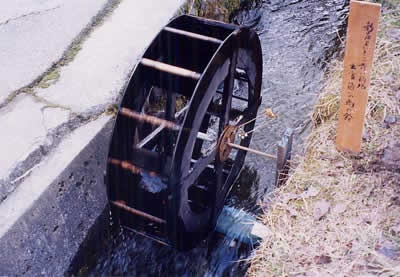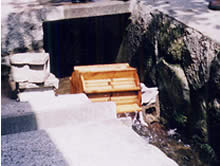| Japanese / English | |
HOME >> Nature Interface 2001.3: Special Features >> Imo Guruma
|
||||||||||
|
||||||||||
Imo Guruma  (1/1)
Shinjo-son Village, located in Maniwa-gun County, Okayama Prefecture, sits in a small basin surrounded by the Chugoku Mountains of Western Japan. The Shinjo River slowly meanders through the village. This village was a post-town on the Izumo Highway that connected Himeji and Matsue in the Edo period, around the 17th century. This village flourished with many cheap lodging houses and palanquin carriers. On both sides of the long highway, which is presently called "Gaisen Sakura Dori Street," there are waterways that were constructed from around the 17th to 19th centuries. Their width is 1 m (ca. 39 in), their depth is 60 cm (ca. 24 in), and their length is 600 m (ca. 650 yd). These waterways were used for washing clothes, vegetables, and dishes, for centuries until water pipes were laid. Now there is a project among the inhabitants of Shijo-son Village, to discover new uses for these waterways. The placement of taro-washing water wheels, called "imo guruma," is one such economic development projects. "Imo guruma" are used for washing vegetables and peeling taros. Their diameter is about 30 cm (ca. 12 in). The wheels are made of Japanese cedars, and people put taro, a starchy root which resembles a potato, and other vegetables in the wheel. The eight fliers on the water wheels spin powerfully as the water flows over them. In olden times, people used imo gurumas for washing vegetables. There are still some people in the town who have private imo gurumas. Taro is harvested from the end of October to the middle of November. In this season, imo gurumas are put to use in the village, and tourists enjoy watching them, along with the beautiful scenery of the surrounding area. In the areas along the waterway that were formerly used as wash places, there are now multicolored carps, that add color to the waterways of this ex-post-town. When spring comes, you can also see cherry trees in full bloom along the waterways. Come enjoy the beautiful and variable scenery of each season at Shijo-son Village, as well as the wonderful water wheels! 
(1/1) |
|Top of this Page|
©2000-2001 Nature Interface. corporation allrights reserved
